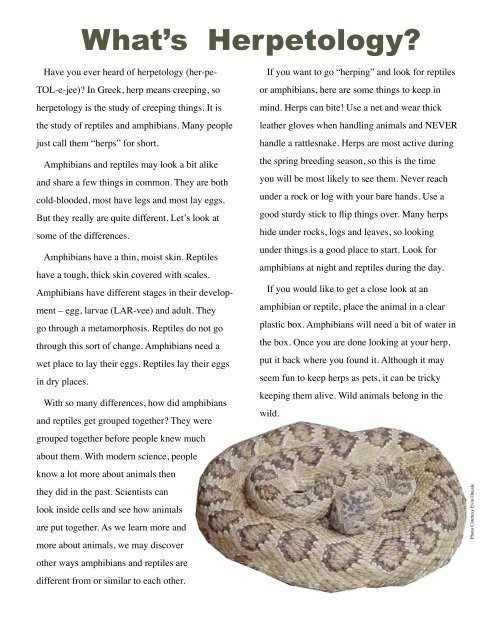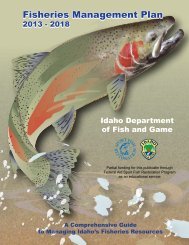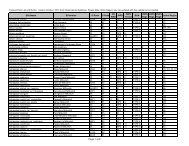May 2010 - Idaho Fish and Game
May 2010 - Idaho Fish and Game
May 2010 - Idaho Fish and Game
Create successful ePaper yourself
Turn your PDF publications into a flip-book with our unique Google optimized e-Paper software.
Have you ever heard of herpetology (her-pe-<br />
TOL-e-jee)? In Greek, herp means creeping, so<br />
herpetology is the study of creeping things. It is<br />
the study of reptiles <strong>and</strong> amphibians. Many people<br />
just call them “herps” for short.<br />
Amphibians <strong>and</strong> reptiles may look a bit alike<br />
<strong>and</strong> share a few things in common. They are both<br />
cold-blooded, most have legs <strong>and</strong> most lay eggs.<br />
But they really are quite different. Let’s look at<br />
some of the differences.<br />
Amphibians have a thin, moist skin. Reptiles<br />
have a tough, thick skin covered with scales.<br />
Amphibians have different stages in their develop-<br />
ment – egg, larvae (LAR-vee) <strong>and</strong> adult. They<br />
go through a metamorphosis. Reptiles do not go<br />
through this sort of change. Amphibians need a<br />
wet place to lay their eggs. Reptiles lay their eggs<br />
in dry places.<br />
What’s Herpetology?<br />
With so many many differences, differences, how did did amphibians<br />
<strong>and</strong> <strong>and</strong> reptiles get grouped together? They were<br />
grouped grouped together together before before people people knew knew much much<br />
about them. With modern science, people<br />
know a lot more about animals then<br />
they did in the past. Scientists can<br />
look inside cells <strong>and</strong> see how animals<br />
are put put together. As we learn more <strong>and</strong><br />
more about animals, we we may discover<br />
other ways amphibians <strong>and</strong> <strong>and</strong> reptiles are are<br />
different from or similar to each other.<br />
If you want to go “herping” <strong>and</strong> look for reptiles<br />
or amphibians, here are some things to keep in<br />
mind. Herps can bite! Use a net <strong>and</strong> wear thick<br />
leather gloves when h<strong>and</strong>ling animals <strong>and</strong> NEVER<br />
h<strong>and</strong>le a rattlesnake. Herps are most active during<br />
the spring breeding season, so this is the time<br />
you will be most likely to see them. Never reach<br />
under a rock or log with your bare h<strong>and</strong>s. Use a<br />
good sturdy stick to flip things over. Many herps<br />
hide under rocks, logs <strong>and</strong> leaves, so looking<br />
under things is a good place to start. Look for<br />
amphibians at night <strong>and</strong> reptiles during the day.<br />
If you would like to get a close look at an<br />
amphibian or reptile, place the animal in a clear<br />
plastic box. Amphibians will need a bit of water in<br />
the box. Once you are done looking at your herp,<br />
put it back where you found it. Although it may<br />
seem fun to keep herps as pets, it can be tricky<br />
keeping them alive. Wild animals belong in the<br />
wild.<br />
Photo Courtesy Evin Oneale













